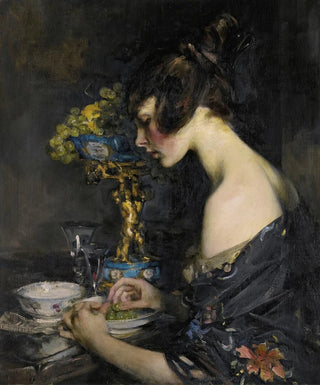Art print | The Sèvres vase - James Jebusa Shannon


View from behind

Frame (optional)
In the vast panorama of art history, certain works stand out for their ability to capture the very essence of an era. "Le vase de Sèvres - James Jebusa Shannon" is one such creation. This painting, imbued with delicacy and sophistication, immerses us in the refined universe of Sèvres porcelain, a symbol of French luxury. Through Shannon's gaze, the artist manages to transcend the simple object to make it a true vessel of emotion and beauty. By contemplating this piece, the viewer is invited to explore the subtleties of the decorative world while marveling at the technical mastery that characterizes it.
Style and uniqueness of the work
James Jebusa Shannon's style is distinguished by meticulous attention to detail and a rich, nuanced color palette. "Le vase de Sèvres" stands out as a shining example of his ability to marry realism and aesthetics. The vase, beautifully decorated, is depicted with precision that highlights the artisanal craftsmanship of the Sèvres manufactory. Floral motifs and gilding are accentuated by carefully studied lighting, creating a play of shadows and light that adds an almost tactile dimension to the artwork. Shannon does not merely pay homage to the beauty of porcelain; he manages to infuse a vibrant and lively atmosphere, where each brushstroke seems to tell a story. This painting thus reveals itself as a dialogue between art and craftsmanship, a tribute to the beauty of everyday objects enhanced by human creativity.
The artist and his influence
James Jebusa Shannon, an American-born painter and portraitist, established himself in the British art scene at the end of the 19th century. His career is marked by a constant desire to explore the relationship between art and life, a quest that finds its culmination in works like "Le vase de Sèvres." Influenced by the artistic movements of his time, notably Pre-Raphaelitism, Shannon develops a style that combines tradition and innovation. His approach, both technical and emotional, had a significant impact on his contemporaries, inspiring a generation of

Matte finish

View from behind

Frame (optional)
In the vast panorama of art history, certain works stand out for their ability to capture the very essence of an era. "Le vase de Sèvres - James Jebusa Shannon" is one such creation. This painting, imbued with delicacy and sophistication, immerses us in the refined universe of Sèvres porcelain, a symbol of French luxury. Through Shannon's gaze, the artist manages to transcend the simple object to make it a true vessel of emotion and beauty. By contemplating this piece, the viewer is invited to explore the subtleties of the decorative world while marveling at the technical mastery that characterizes it.
Style and uniqueness of the work
James Jebusa Shannon's style is distinguished by meticulous attention to detail and a rich, nuanced color palette. "Le vase de Sèvres" stands out as a shining example of his ability to marry realism and aesthetics. The vase, beautifully decorated, is depicted with precision that highlights the artisanal craftsmanship of the Sèvres manufactory. Floral motifs and gilding are accentuated by carefully studied lighting, creating a play of shadows and light that adds an almost tactile dimension to the artwork. Shannon does not merely pay homage to the beauty of porcelain; he manages to infuse a vibrant and lively atmosphere, where each brushstroke seems to tell a story. This painting thus reveals itself as a dialogue between art and craftsmanship, a tribute to the beauty of everyday objects enhanced by human creativity.
The artist and his influence
James Jebusa Shannon, an American-born painter and portraitist, established himself in the British art scene at the end of the 19th century. His career is marked by a constant desire to explore the relationship between art and life, a quest that finds its culmination in works like "Le vase de Sèvres." Influenced by the artistic movements of his time, notably Pre-Raphaelitism, Shannon develops a style that combines tradition and innovation. His approach, both technical and emotional, had a significant impact on his contemporaries, inspiring a generation of






